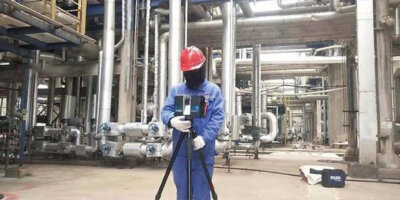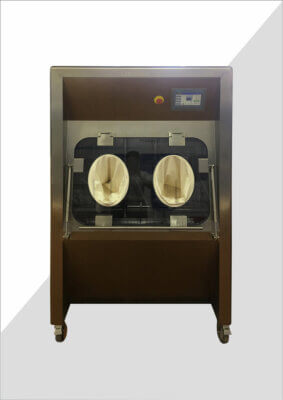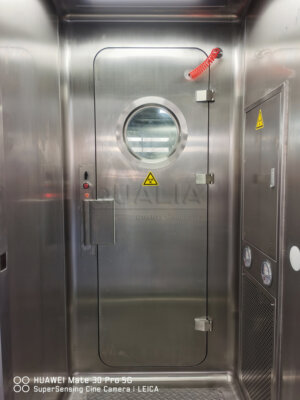In today's world of advanced biotechnology and medical research, the proper handling and treatment of potentially hazardous liquid waste is paramount. An effective Effluent Decontamination System (EDS) plays a crucial role in ensuring the safety of laboratory personnel, the public, and the environment. This article delves into the essential components that make up a robust and reliable EDS, exploring the latest technologies and best practices in the field.
From containment vessels to treatment processes, monitoring systems to fail-safe mechanisms, we'll examine how each element contributes to the overall efficiency and effectiveness of an EDS. Whether you're designing a new system or looking to upgrade an existing one, understanding these key components is essential for maintaining the highest standards of safety and compliance in your facility.
As we transition into the main content, it's important to note that the design and implementation of an EDS is not a one-size-fits-all solution. Each system must be tailored to the specific needs of the facility, taking into account factors such as the types of pathogens handled, the volume of waste generated, and local regulatory requirements. However, certain fundamental components are universal to all effective systems.
An effective Effluent Decontamination System is critical for the safe handling and disposal of potentially hazardous liquid waste in research and medical facilities, protecting both personnel and the environment from biological and chemical threats.
| Component | Function | Importance |
|---|---|---|
| Containment Vessels | Store untreated effluent | High |
| Treatment Tanks | Process and decontaminate effluent | Critical |
| Chemical Dosing Systems | Add disinfectants or neutralizing agents | High |
| Heat Exchangers | Maintain optimal treatment temperatures | Critical |
| Monitoring and Control Systems | Ensure proper operation and safety | Critical |
| Filtration Systems | Remove solids and particulates | Medium to High |
| Ventilation Systems | Control odors and airborne contaminants | Medium |
| Emergency Overflow Systems | Prevent spills during system failures | High |
What are the primary containment vessels in an EDS?
The first line of defense in any Effluent Decontamination System is the primary containment vessel. These tanks are designed to safely hold untreated liquid waste before it enters the treatment process.
Primary containment vessels are typically made of corrosion-resistant materials such as stainless steel or specially coated concrete. They must be able to withstand the chemical and biological properties of the effluent while preventing any leaks or emissions.
The size and number of containment vessels depend on the facility's waste generation rate and the capacity of the treatment system. Proper design ensures that there's always sufficient storage capacity, even during peak production times or system maintenance.
Primary containment vessels in an EDS must be constructed of materials resistant to both chemical and biological corrosion, with capacities ranging from hundreds to thousands of gallons depending on facility needs.
| Vessel Type | Capacity Range | Material |
|---|---|---|
| Small-scale | 100-500 gallons | Stainless Steel |
| Medium-scale | 500-2000 gallons | Coated Concrete |
| Large-scale | 2000+ gallons | Reinforced Fiberglass |
How do treatment tanks contribute to effluent decontamination?
Treatment tanks are the heart of the Effluent Decontamination System, where the actual process of neutralizing hazardous waste occurs. These tanks are designed to facilitate various treatment methods, including thermal, chemical, and combined approaches.
In thermal treatment systems, the tanks are equipped with heating elements or steam jackets to raise the temperature of the effluent to levels that effectively kill pathogens. Chemical treatment tanks, on the other hand, are designed to allow for the thorough mixing of disinfectants or neutralizing agents with the waste.
Advanced treatment tanks may incorporate features such as agitators to ensure uniform treatment, baffles to increase contact time, and specialized coatings to withstand aggressive chemicals or high temperatures. The design of these tanks is critical to the overall efficiency of the decontamination process.
Treatment tanks in an EDS must be capable of withstanding extreme conditions, including temperatures up to 135°C and exposure to corrosive chemicals, while maintaining their structural integrity and containment properties.
| Treatment Method | Temperature Range | Contact Time |
|---|---|---|
| Thermal | 121-135°C | 15-30 minutes |
| Chemical | 20-60°C | 30-120 minutes |
| Thermochemical | 60-100°C | 45-90 minutes |
What role do chemical dosing systems play in effluent treatment?
Chemical dosing systems are essential components in many Effluent Decontamination Systems, particularly those that rely on chemical or combined thermochemical treatment methods. These systems are responsible for accurately measuring and dispensing disinfectants, neutralizing agents, or other treatment chemicals into the effluent stream.
Precise dosing is crucial for ensuring effective treatment while minimizing chemical usage and potential environmental impact. Modern dosing systems often incorporate advanced sensors and control mechanisms to adjust chemical addition based on real-time measurements of effluent properties such as pH, oxidation-reduction potential (ORP), or turbidity.
The choice of chemicals used in the dosing system depends on the nature of the contaminants and the specific treatment goals. Common options include chlorine-based disinfectants, peracetic acid, hydrogen peroxide, and various pH adjusters.
Chemical dosing systems in EDS must be capable of delivering precise amounts of treatment chemicals, with dosing accuracies typically within ±1% to ensure optimal decontamination effectiveness and regulatory compliance.
| Chemical Type | Dosing Range | Application |
|---|---|---|
| Sodium Hypochlorite | 5-15 mg/L | Disinfection |
| Peracetic Acid | 100-500 ppm | Sterilization |
| Sodium Hydroxide | 0.1-1 mol/L | pH Adjustment |
How do heat exchangers maintain optimal treatment temperatures?
Heat exchangers play a critical role in thermal and thermochemical Effluent Decontamination Systems by efficiently raising and maintaining the temperature of the effluent to levels required for effective pathogen inactivation. These devices transfer heat from a hot medium (typically steam or hot water) to the effluent without direct contact between the two fluids.
The design of heat exchangers used in EDS applications must account for the potentially corrosive nature of the effluent and the need for easy cleaning and maintenance. Common types include plate heat exchangers, which offer high efficiency and compact design, and shell-and-tube exchangers, which are robust and suitable for high-temperature applications.
Advanced heat exchanger systems may incorporate features such as double-wall construction for added safety, self-cleaning mechanisms to prevent fouling, and precise temperature control to ensure uniform treatment throughout the effluent volume.
Heat exchangers in EDS must be capable of rapidly heating effluent to sterilization temperatures, typically achieving a temperature rise of 100°C or more within minutes while maintaining energy efficiency.
| Heat Exchanger Type | Efficiency | Temperature Range |
|---|---|---|
| Plate | 90-95% | Up to 150°C |
| Shell-and-Tube | 85-90% | Up to 200°C |
| Spiral | 92-97% | Up to 180°C |
What monitoring and control systems ensure proper EDS operation?
Monitoring and control systems are the nerve center of an Effluent Decontamination System, ensuring that all components function correctly and that the treatment process meets regulatory standards. These systems typically include a combination of sensors, controllers, and data logging equipment.
Key parameters monitored in an EDS include temperature, pressure, pH, flow rate, and chemical concentrations. Advanced systems may also incorporate real-time biological indicators to verify pathogen inactivation. The control system uses this data to adjust treatment parameters, activate alarms, or initiate emergency shutdown procedures when necessary.
Many modern EDS installations feature QUALIA advanced monitoring and control systems, which offer integrated solutions for comprehensive system management, including remote monitoring capabilities and predictive maintenance features.
State-of-the-art EDS monitoring systems can detect deviations from optimal treatment conditions within seconds, allowing for rapid corrective actions to maintain decontamination efficacy and prevent potential hazards.
| Parameter | Monitoring Range | Accuracy |
|---|---|---|
| Temperature | 0-150°C | ±0.5°C |
| pH | 0-14 | ±0.1 pH |
| ORP | -2000 to +2000 mV | ±5 mV |
| Flow Rate | 0-1000 L/min | ±1% |
How do filtration systems enhance effluent treatment?
Filtration systems are crucial components in many Effluent Decontamination Systems, serving to remove solid particles, microorganisms, and other contaminants from the liquid waste stream. Effective filtration not only improves the overall treatment efficiency but also protects downstream equipment from damage and fouling.
The type of filtration used in an EDS depends on the characteristics of the effluent and the specific treatment goals. Common options include microfiltration for removing larger particles and bacteria, ultrafiltration for virus removal, and reverse osmosis for the most stringent purification requirements.
Advanced filtration systems may incorporate self-cleaning mechanisms, such as backwashing or air scouring, to maintain filter efficiency and reduce maintenance requirements. Some designs also feature multiple stages of filtration, progressively removing smaller particles to achieve the desired level of purity.
High-performance filtration systems in EDS can achieve removal efficiencies of up to 99.9999% for bacteria and 99.99% for viruses, ensuring that treated effluent meets even the most stringent regulatory standards.
| Filtration Type | Pore Size | Removal Efficiency |
|---|---|---|
| Microfiltration | 0.1-10 μm | 99.9% (bacteria) |
| Ultrafiltration | 0.01-0.1 μm | 99.99% (viruses) |
| Nanofiltration | 0.001-0.01 μm | 99.9% (organic molecules) |
What safety features are essential in an EDS?
Safety features are paramount in the design and operation of any Effluent Decontamination System, given the potentially hazardous nature of the materials being handled. These features are designed to protect personnel, prevent environmental contamination, and ensure system integrity under all conditions.
Key safety components include redundant sensors and alarms to detect system malfunctions, emergency shutdown mechanisms, and containment measures to prevent accidental releases. Many systems also incorporate fail-safe designs that default to a safe state in the event of power loss or component failure.
Personal protective equipment (PPE) stations, eye wash stations, and safety showers are typically installed near EDS facilities to provide immediate response capabilities in case of exposure. Additionally, ventilation systems with HEPA filtration may be used to control airborne contaminants and odors.
Modern EDS designs often include triple redundancy in critical safety systems, with the ability to maintain safe operation even if two out of three components fail, ensuring a probability of failure as low as 10^-6 per year.
| Safety Feature | Function | Reliability |
|---|---|---|
| Emergency Shutdown | Rapid system halt | 99.999% |
| Containment Dykes | Secondary spill control | 99.99% |
| HEPA Filtration | Airborne contaminant control | 99.97% |
How are EDS components integrated for optimal performance?
The integration of all components in an Effluent Decontamination System is crucial for achieving optimal performance, reliability, and safety. This integration involves not only the physical connections between different parts of the system but also the coordination of their functions through advanced control systems.
A well-integrated EDS ensures smooth flow from initial containment through treatment and final discharge, with each component working in harmony to achieve the desired decontamination results. This often involves careful sequencing of operations, such as pre-heating effluent before chemical dosing or activating filtration systems at specific points in the treatment process.
Modern integration approaches often leverage IoT (Internet of Things) technologies to create smart, interconnected systems. These can adapt to changing conditions, optimize resource usage, and provide comprehensive data for analysis and reporting.
Fully integrated EDS can achieve overall system efficiencies of up to 95%, significantly reducing energy consumption and operating costs while maintaining or improving treatment effectiveness compared to non-integrated systems.
| Integration Level | Efficiency Gain | Cost Reduction |
|---|---|---|
| Basic | 5-10% | 10-15% |
| Advanced | 15-25% | 20-30% |
| Fully Integrated | 25-35% | 30-40% |
In conclusion, an effective Effluent Decontamination System is a complex yet essential component of any facility handling potentially hazardous biological or chemical waste. By understanding and optimizing each of the key components discussed – from containment vessels and treatment tanks to advanced monitoring and safety systems – facilities can ensure the highest levels of safety, compliance, and operational efficiency.
As technology continues to advance, we can expect to see even more sophisticated EDS solutions emerging, with greater automation, improved energy efficiency, and enhanced integration capabilities. However, the fundamental principles of effective containment, treatment, and safety will remain at the core of these systems, ensuring that they continue to play a vital role in protecting public health and the environment.
For facilities looking to implement or upgrade their Effluent Decontamination Systems, partnering with experienced providers like QUALIA can provide access to cutting-edge technologies and expertise, ensuring that your system is tailored to your specific needs and operates at peak performance. By investing in a well-designed and properly maintained EDS, organizations can demonstrate their commitment to safety, environmental stewardship, and responsible research practices.
External Resources
Effluent Decontamination systems – Belgian Biosafety Server – This resource provides a detailed description of both batch and continuous flow effluent decontamination systems, including their design, operation, and the processes involved in thermal and chemical treatment.
EDS – Effluent Decontamination Systems – Burt Process Equipment – This link offers information on various types of effluent decontamination systems, including high-temperature continuous batch, thermochemical, chemical, continuous flow, and under sink systems, highlighting their features and applications.
Effluent Decontamination Systems: Addressing the Challenges of … – Liebert Pub – This article discusses the challenges and considerations in designing and operating effluent decontamination systems, including the use of steam, hot oil, and chemical sterilization methods, as well as environmental and operational factors.
Effluent decontamination system – Wikipedia – This Wikipedia entry provides an overview of effluent decontamination systems, including their types (batch steam, batch steam injection, continuous flow, and batch chemical systems), and the facilities that use them.
ThermoDecoN™ | Low Pressure Batch Effluent Decontamination … – PRI Systems – This resource details the ThermoDecoN™ system, a low-pressure batch effluent decontamination system designed for small facilities, highlighting its simplicity, automatic operation, and validation features.
Related Contents:
- Continuous Effluent Decontamination: Protecting Our Environment
- Effluent Decontamination: Essential for High-Risk Labs
- Thermal Effluent Decontamination: Protecting Our Environment
- Effluent Decontamination Systems for Biosafety Laboratories
- Effluent Decontamination Systems: Safeguarding Malaysia’s Environment
- Effluent Decontamination Systems: Safeguarding Pharmaceutical Waste Management
- Effluent Decontamination Systems: Safeguarding Biosafety in Laboratories
- Effluent Decontamination: Safeguarding Our Environment
- Effluent Decontamination Systems: Safeguarding BSL-2, 3, and 4 Labs





























